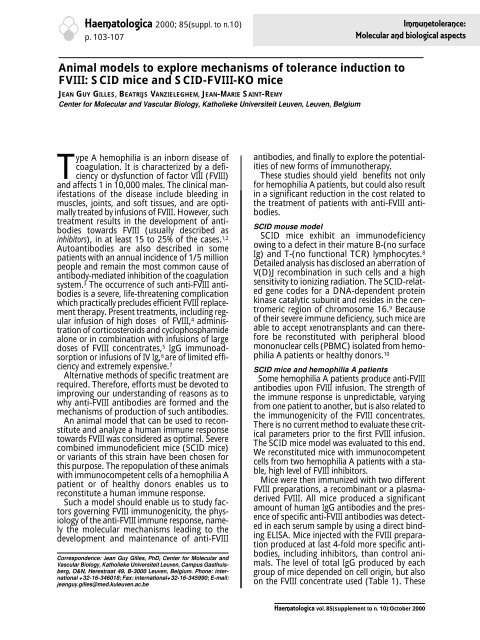Haematologica 2000;85:supplement to no. 10 - Supplements ...
Haematologica 2000;85:supplement to no. 10 - Supplements ...
Haematologica 2000;85:supplement to no. 10 - Supplements ...
You also want an ePaper? Increase the reach of your titles
YUMPU automatically turns print PDFs into web optimized ePapers that Google loves.
<strong>Haema<strong>to</strong>logica</strong> <strong>2000</strong>; <strong>85</strong>(suppl. <strong>to</strong> n.<strong>10</strong>)<br />
p. <strong>10</strong>3-<strong>10</strong>7<br />
Immune<strong>to</strong>lerance:<br />
Molecular and biological aspects<br />
Animal models <strong>to</strong> explore mechanisms of <strong>to</strong>lerance induction <strong>to</strong><br />
FVIII: SCID mice and SCID-FVIII-KO mice<br />
JEAN GUY GILLES, BEATRIJS VANZIELEGHEM, JEAN-MARIE SAINT-REMY<br />
Center for Molecular and Vascular Biology, Katholieke Universiteit Leuven, Leuven, Belgium<br />
Type A hemophilia is an inborn disease of<br />
coagulation. It is characterized by a deficiency<br />
or dysfunction of fac<strong>to</strong>r VIII (FVIII)<br />
and affects 1 in <strong>10</strong>,000 males. The clinical manifestations<br />
of the disease include bleeding in<br />
muscles, joints, and soft tissues, and are optimally<br />
treated by infusions of FVIII. However, such<br />
treatment results in the development of antibodies<br />
<strong>to</strong>wards FVIII (usually described as<br />
inhibi<strong>to</strong>rs), in at least 15 <strong>to</strong> 25% of the cases. 1,2<br />
Au<strong>to</strong>antibodies are also described in some<br />
patients with an annual incidence of 1/5 million<br />
people and remain the most common cause of<br />
antibody-mediated inhibition of the coagulation<br />
system. 3 The occurrence of such anti-FVIII antibodies<br />
is a severe, life-threatening complication<br />
which practically precludes efficient FVIII replacement<br />
therapy. Present treatments, including regular<br />
infusion of high doses of FVIII, 4 administration<br />
of corticosteroids and cyclophosphamide<br />
alone or in combination with infusions of large<br />
doses of FVIII concentrates, 5 IgG immu<strong>no</strong>adsorption<br />
or infusions of IV Ig, 6 are of limited efficiency<br />
and extremely expensive. 7<br />
Alternative methods of specific treatment are<br />
required. Therefore, efforts must be devoted <strong>to</strong><br />
improving our understanding of reasons as <strong>to</strong><br />
why anti-FVIII antibodies are formed and the<br />
mechanisms of production of such antibodies.<br />
An animal model that can be used <strong>to</strong> reconstitute<br />
and analyze a human immune response<br />
<strong>to</strong>wards FVIII was considered as optimal. Severe<br />
combined immu<strong>no</strong>deficient mice (SCID mice)<br />
or variants of this strain have been chosen for<br />
this purpose. The repopulation of these animals<br />
with immu<strong>no</strong>competent cells of a hemophilia A<br />
patient or of healthy do<strong>no</strong>rs enables us <strong>to</strong><br />
reconstitute a human immune response.<br />
Such a model should enable us <strong>to</strong> study fac<strong>to</strong>rs<br />
governing FVIII immu<strong>no</strong>genicity, the physiology<br />
of the anti-FVIII immune response, namely<br />
the molecular mechanisms leading <strong>to</strong> the<br />
development and maintenance of anti-FVIII<br />
Correspondence: Jean Guy Gilles, PhD, Center for Molecular and<br />
Vascular Biology, Katholieke Universiteit Leuven, Campus Gasthuisberg,<br />
O&N, Herestraat 49, B-3000 Leuven, Belgium. Phone: international<br />
+32-16-346018; Fax: international+32-16-345990; E-mail:<br />
jeanguy.gilles@med.kuleuven.ac.be<br />
antibodies, and finally <strong>to</strong> explore the potentialities<br />
of new forms of immu<strong>no</strong>therapy.<br />
These studies should yield benefits <strong>no</strong>t only<br />
for hemophilia A patients, but could also result<br />
in a significant reduction in the cost related <strong>to</strong><br />
the treatment of patients with anti-FVIII antibodies.<br />
SCID mouse model<br />
SCID mice exhibit an immu<strong>no</strong>deficiency<br />
owing <strong>to</strong> a defect in their mature B-(<strong>no</strong> surface<br />
Ig) and T-(<strong>no</strong> functional TCR) lymphocytes. 8<br />
Detailed analysis has disclosed an aberration of<br />
V(D)J recombination in such cells and a high<br />
sensitivity <strong>to</strong> ionizing radiation. The SCID-related<br />
gene codes for a DNA-dependent protein<br />
kinase catalytic subunit and resides in the centromeric<br />
region of chromosome 16. 9 Because<br />
of their severe immune deficiency, such mice are<br />
able <strong>to</strong> accept xe<strong>no</strong>transplants and can therefore<br />
be reconstituted with peripheral blood<br />
mo<strong>no</strong>nuclear cells (PBMC) isolated from hemophilia<br />
A patients or healthy do<strong>no</strong>rs. <strong>10</strong><br />
SCID mice and hemophilia A patients<br />
Some hemophilia A patients produce anti-FVIII<br />
antibodies upon FVIII infusion. The strength of<br />
the immune response is unpredictable, varying<br />
from one patient <strong>to</strong> a<strong>no</strong>ther, but is also related <strong>to</strong><br />
the immu<strong>no</strong>genicity of the FVIII concentrates.<br />
There is <strong>no</strong> current method <strong>to</strong> evaluate these critical<br />
parameters prior <strong>to</strong> the first FVIII infusion.<br />
The SCID mice model was evaluated <strong>to</strong> this end.<br />
We reconstituted mice with immu<strong>no</strong>competent<br />
cells from two hemophilia A patients with a stable,<br />
high level of FVIII inhibi<strong>to</strong>rs.<br />
Mice were then immunized with two different<br />
FVIII preparations, a recombinant or a plasmaderived<br />
FVIII. All mice produced a significant<br />
amount of human IgG antibodies and the presence<br />
of specific anti-FVIII antibodies was detected<br />
in each serum sample by using a direct binding<br />
ELISA. Mice injected with the FVIII preparation<br />
produced at last 4-fold more specific antibodies,<br />
including inhibi<strong>to</strong>rs, than control animals.<br />
The level of <strong>to</strong>tal IgG produced by each<br />
group of mice depended on cell origin, but also<br />
on the FVIII concentrate used (Table 1). These<br />
<strong>Haema<strong>to</strong>logica</strong> vol. <strong>85</strong>(<strong>supplement</strong> <strong>to</strong> n. <strong>10</strong>):Oc<strong>to</strong>ber <strong>2000</strong>
















